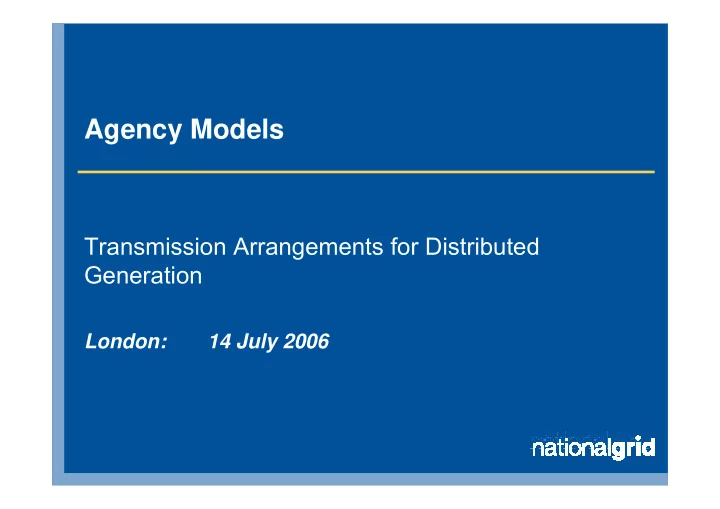

Agency Models Transmission Arrangements for Distributed Generation London: 14 July 2006
Structure � The Problem (National Grid perspective) � Agency Model Options � Three Strawmen for discussion
The Problems � Cost reflectivity of transmission charges falls as unlicensed embedded generation increases All generation has an effect on transmission flows � Not just about exporting GSPs � � Governance framework does not recognise flow from distribution to transmission without a BEGA No access product � � No operational control where transmission affected DNO networks effectively becoming active � � Investment planning and locational signals Embedded Generation growth � � Specific issues in Scotland More than just a charging issue, only agency models can resolve
What do we mean by “Agency”? � Single point of contact/ interface � Aggregator of capacity and energy � Controller of despatch � Who? Options: X � “GBSO” to extend into DNO networks? � 14 DNOs to become “active” – DNO Agency � Use Supplier interface – Supplier Agency
Key Considerations � Gross v Net � Should embedded generation net from demand? Transmission Charges based on “spill” or installed capacity? � � Appropriate threshold? � Nodes v Zones � Would a defined transmission access product be nodal or zonal? � The degree of change � What are we assuming the agent will do?
Agency Model Matrix Gross of Gross of Net of Net of GSP GSP Group GSP GSP Group Very Difficult, Strawman 3 Strawman 1 SVA at GSP Group level, Supplier Agency “TODAY” Would need to (sort of) Re-register 23m meters “Interconnector Strawman 2 model” Nodal Nodal DNO Agency Model Model Possible, but Superior Superior involves a lot of change
Why these Strawmen - objectives � “Gross” for cost reflective charging � “Nodal” (where pragmatic) for operational control � Supplier agent for least change, but DNO Agent could work if it was fully active � We think DNO Agent is a lot of change
Supplier v DNO Agent DNO Agency Supplier Agency � � Pros Simple conceptually Uses existing settlement structure � � Physical alignment Efficient charging signals � � Clear operational boundaries of Could be implemented in short term responsibility � DNO bids and offers on a nodal basis � � Cons Major industry restructuring Association of bids/ offers with nodes � � 14 control rooms How does DNO resolve constraints and � DNO trading energy? actively manage the system? – does it need to? � � How BM interaction managed? SO despatching plant on another system – � Methodology to pass transmission safety/ security/ MVar � charges to suppliers SO would be issuing BOAs via Supplier � Treatment of large embedded Agency � Reform of exit product � If “net” model, max export to Grid not at system peak � Definition of service – response/ reactive
Gross Zonal Supplier Agency Model (GZSAM) - Introduction to Strawman 1 Today Demand Generation HHg1 EG Netted off M 1 Generation For a ∑ HHd - ∑ HHg + ∑ NHHd GSP BMU Supplier, HHd1 D HH £/kW NHH p/kWh £/kW Zonal Zonal Gen TNUoS NHHd1 GSP Dem Tariff Dem Tariff Tariff GROUP zTEC Generation HHg2 GZSAM EG BMU ∑ HHd + ∑ NHHd M 2 HHg1 + HHg2 GSP + HHg2 HH £/kW NHH p/kWh £/kW £/kW D Zonal Gen TNUoS Zonal Gen TNUoS Dem Tariff Tariff Dem Tariff Tariff NHHd2 Transmission Distribution In the BM, aggregated zonal embedded generation Network Network might be offered to the SO in a single “sub-BMU”
Gross Nodal DNO Agent Model (GNDAM) - Introduction to Strawman 2 TODAY GDAM DC Gen DC Gen DC Gen DC Gen TEC TEC National Grid National Grid National Grid National Grid TEC Operational TEC DNO DNO DNO DNO interface Sum of Suppliers BEGA Export BEGA (negative demand) capability SVA LEEG SVA LEEG CVA LEEG CVA LEEG
Gross Nodal Supplier Agency Model (GNSAM) - Introduction to Strawman 3 Today Demand Generation HHg1 EG Netted off M 1 Generation For a ∑ HHd - ∑ HHg + ∑ NHHd GSP BMU Supplier, HHd1 D HH £/kW NHH p/kWh £/kW Zonal Zonal Gen TNUoS NHHd1 GSP Dem Tariff Dem Tariff Tariff GROUP TEC TEC Generation HHg2 GNSAM EG BMU ∑ HHd + ∑ NHHd M 2 HHg1 HHg2 GSP + + HHg2 HH £/kW NHH p/kWh £/kW £/kW £/kW D Zonal Gen TNUoS Zonal Gen TNUoS Gen TNUoS Dem Tariff Tariff Dem Tariff Tariff Tariff NHHd2 Transmission Distribution Each embedded generator above a given threshold Network Network might be offered to the SO as a single BMU
Summary � There are different approaches � None of the agency models are simple � We think “gross” and “nodal” are important � cf. “net” and “zonal” today � No preference which agent � DNO conceptually simpler � Supplier least change Other Agency ideas?
The Problem - National Grid Perspective - “Gross” Background All generation has an effect on transmission flows EG within +ve generation TNUoS charging zones can reduce local demand, Transmission constraint but may increase flows south Similarly, EG within negative generation Power flow south TNUoS charging zones may reduce flows south GSPs do not have to be exporting to affect transmission
Impact of Embedded Generation - “Gross” Background 10MW 10MW EG EG Power Flow = 10MW Power Flow = 100MW 100+X MW G Transmission Transmission System G G System Importing Zone Exporting Zone Physical constraint G 100MW 10MW D EG EG D 10MW 10MW Impact is the same as transmission connected 10MW
Recommend
More recommend